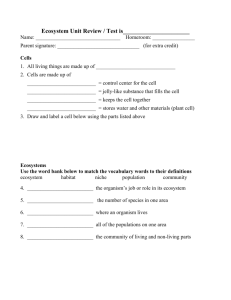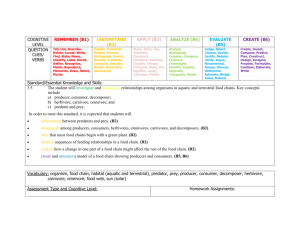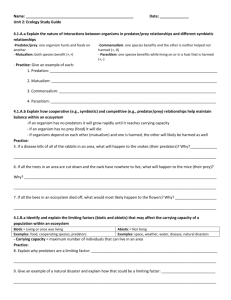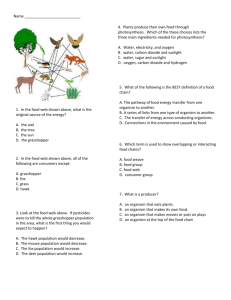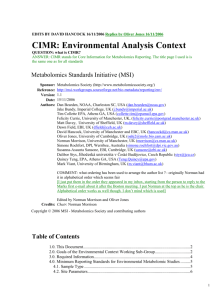Ecosystem Unit Summary / Key Ideas
advertisement
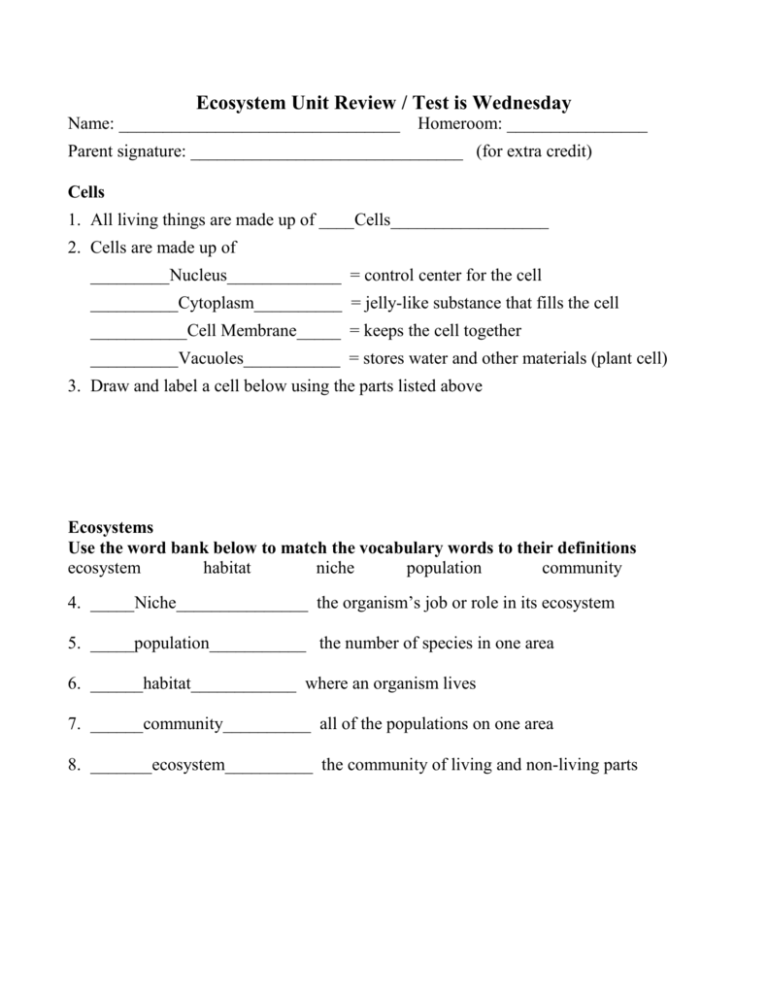
Ecosystem Unit Review / Test is Wednesday Name: ________________________________ Homeroom: ________________ Parent signature: _______________________________ (for extra credit) Cells 1. All living things are made up of ____Cells__________________ 2. Cells are made up of _________Nucleus_____________ = control center for the cell __________Cytoplasm__________ = jelly-like substance that fills the cell ___________Cell Membrane_____ = keeps the cell together __________Vacuoles___________ = stores water and other materials (plant cell) 3. Draw and label a cell below using the parts listed above Ecosystems Use the word bank below to match the vocabulary words to their definitions ecosystem habitat niche population community 4. _____Niche_______________ the organism’s job or role in its ecosystem 5. _____population___________ the number of species in one area 6. ______habitat____________ where an organism lives 7. ______community__________ all of the populations on one area 8. _______ecosystem__________ the community of living and non-living parts Use the word bank below to match the vocabulary words to their definitions herbivore consumer parasite omnivore carnivore decomposer producer host 9. ___carnivore__________ an animal that only eats meat 10.___decomposer________ an organism that breaks down other dead organisms 11.___producer___________ an organism that makes its own energy from the sun 12.____herbivore__________ an animal that only eats plants 13.____parasite____________ an organism that feeds but does not kill another 14._____consumer__________ an organism that has to eat to get energy 15._____host______________ an organism that is fed off of by a parasite 16._____omnivore__________ an animal that eats both plants and animals 17. Draw a food chain using the following parts: carnivore, sunlight, decomposer, producer, and herbivore. BE SURE TO USE ARROWS TO SHOW HOW THE ENERGY MOVES THROUGH THE FOOD CHAIN. 18.What are four common abiotic (non-living) elements in an ecosystem? Circle the most important abiotic element in most ecosystems. 1) water 2) air 3) temperature 4) sunlight 19.How do plants turn sunlight into energy (what is the name of this process)? Photosynthesis 20.What are the four major limiting factors for plant and animal populations? 1) air 2) living space 5) water 3) shelter 4) food 21.Make a simple food web that includes the following: BE SURE TO USE ARROWS TO SHOW HOW THE ENERGY MOVES THROUGH THE FOOD CHAIN. Sunlight Grass Oak tree Squirrel Mouse Small bird Grasshopper Owl Decomposers 22. Explain how the populations of predators and prey are related. Predators eat the prey. The more predators the less prey. The less predators the more prey Match the ecosystems to the descriptions below. forest ocean pond estuary wetlands lake grassland 23.___grassland_________ terrestrial, dry soil, filled with grasses, few trees 24.___lake______________ aquatic, fresh - still water, larger than a pond 25.____ocean____________ aquatic, salt water, very large 26.____forest___________ terrestrial, good amount of rain, filled with trees 27.____estuary____________ aquatic and terrestrial, where a river meets the ocean 28._____pond_________ aquatic, fresh – still water, smaller than a lake 29._____wetlands_______ aquatic and terrestrial, habitat for many animals and plants Extra credit: show the chemical equation for photosynthesis below ___sunlight__________________ + _____6CO 2 __________ + __6H O__________ 2 ____C H O ____________ + ______6O ___________ 6 12 2
